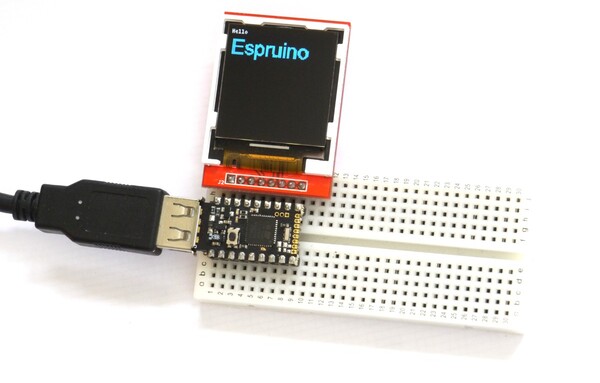ILI9163 LCD controller

This is a common LCD controller for 128x128 LCDs. These are available cheaply from via various suppliers online, often marketed as 'Nokia 5110 LCD Replacements' - While the modules are pin compatible, they're not software compatible and require this driver instead of the PCD8544 one.
Support is included in the ILI9163 (About Modules) module, using the Graphics library.
Just wire up as follows:
| LCD pin | Pin type | Example pin on Espruino Board |
|---|---|---|
| VCC | Power | B15 or 3.3v |
| GND | Power | B14 or GND |
| CS/CE | GPIO | B13 |
| RST | GPIO | B10 or 3.3v |
| A0/DC | GPIO | B1 |
| SDA | SPI MOSI | A7 |
| SCL | SPI SCK | A6 |
| LED | GPIO/Power | A5 or 3.3v |
Note: The display takes around 200ms to initialise after calling 'connect'. There's an optional callback that is called after this time (shown in the examples). Sending data to it before initialisation may cause it not to initialise correctly.
Normal mode
B15.set();// VCC
B14.reset(); // GND
A5.set(); // Backlight On
var spi = new SPI();
spi.setup({mosi:A7 /* sda */, sck:A6 /* scl */});
var g = require("ILI9163").connect(spi, B1 /* DC */, B13 /* CE */, B10 /* RST */, function() {
g.clear();
g.setRotation(2);
g.drawString("Hello",0,0);
g.setFontVector(20);
g.setColor(0,0.5,1);
g.drawString("Espruino",0,10);
});
This module doesn't use a double-buffer as it would use up almost all the RAM - 128 * 128 * 16bpp = 32768 bytes. Pixels are written to the display as they are drawn, so you will get some flicker and relatively slow updates. See the next heading for another option
Paletted Mode
B15.set();// VCC
B14.reset(); // GND
A5.set(); // Backlight On
var colorPalette = new Uint16Array([0, 0xF80F, 0x001F, 0xFFFF]);
var spi = new SPI();
spi.setup({mosi:A7 /* sda */, sck:A6 /* scl */});
var g = require("ILI9163").connectPaletted(colorPalette, spi, B1 /* DC */, B13 /* CE */, B10 /* RST */, function() {
g.clear();
g.setRotation(2);
g.setColor(3);
g.drawString("Hello",0,0);
g.setColor(1);
g.setFontVector(20);
g.drawString("Espruino",0,10);
g.flip();
});
As there isn't enough RAM to store full 16 bit pixels of the LCD display in Espruino's RAM, this stores a paletted version of the data. For instance if you only need 4 colours, these can be stored as 2 bits per pixel rather than 16. The buffer then takes 128 * 128 / 4 = 4096 bytes which will fit into the available RAM.
This means that all drawing functions can be done much more quickly offscreen, and then the LCD can be updated in one go (removing flicker).
To use this module, simply use the connectPaletted function and supply a palette array as the first argument. The palette can be either 1, 2, 4 or 8 bits - so the array should be either 2, 4, 16 or 256 elements. Then, when you use setColor, the number you supply corresponds to that array element in the palette array,
Using
(No tutorials are available yet)
Buying
This page is auto-generated from GitHub. If you see any mistakes or have suggestions, please let us know.